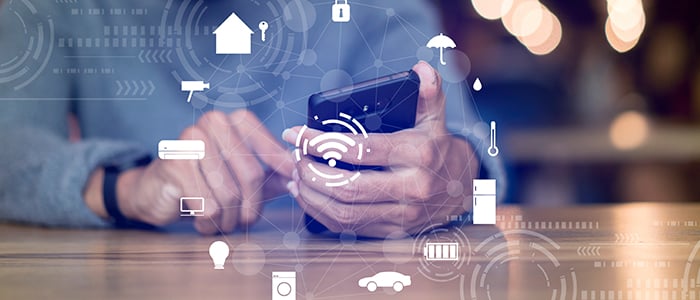
Constant connectivity can be incredibly convenient. But could it be costing us our security?
By 2025, it’s anticipated that there will be more than 100 billion connected IoT devices around the globe. If that number seems like an exaggeration, ask yourself this question: how many connected devices do you encounter every day? They’re everywhere – in our cities, in our workplaces, in our homes, and on our bodies.
While the prospect of constant connectivity, its convenience and its economic impact ($11 trillion globally!) seem great, there are potential risks to be considered as well. Let’s take a closer look at how many of us are being affected in a constantly connected world.
The Benefits of Connectivity
Let’s be honest: in terms of convenience, connectivity has changed our lives for the better—particularly at home. With the ability to keep our various devices connected through a single interface, the connectivity offered by home automation saves time and increases comfort. One swipe in a connected app or one command to a smart speaker and a homeowner can enjoy benefits like increased energy efficiency or enhanced home security in the blink of an eye.
A Threat to Privacy and Security
One has to wonder though, with this many connections, are we providing access to some uninvited guests? Take your voice assistant, for example. That device manufacturer is privy to any conversations users have with the device—and may be eavesdropping on others. Employing the legal protection granted by the phrase ‘but not limited to’ in their device privacy policies, these companies are collecting active and passive data about users around the clock. Can you trust them with your information?
Moreover, can you trust them to keep your data from being accessed by other parties? There is increasing evidence that many popular home IoT devices are highly vulnerable to hacking and other security exploitation. In just one instance, hackers accessed one user’s baby monitor turning it into a spy cam. Scary stuff.
So, Who is Responsible?
Ultimately, the responsibility to maintain the benefits of connectivity and limit its risks falls to several parties. First, consumers should be vigilant to protect their personal information and not give out data unnecessarily. Modifying settings on connected devices to help increase privacy is a good place to start.
Secondly, device manufacturers should also engage in practices that prompt consumers to remember the importance of privacy—and take action to protect themselves.
And finally, the government should enact legislation that keeps manufacturers honest. Simple regulations could go a long way to hold device makers responsible to ensure consumer privacy and security.
Until then, consumers should be sure to be careful while enjoying their connected lifestyles. The benefits are great, but the risks are very real.
For more on how connectivity is influencing our world, check out the Fortegra blog.



